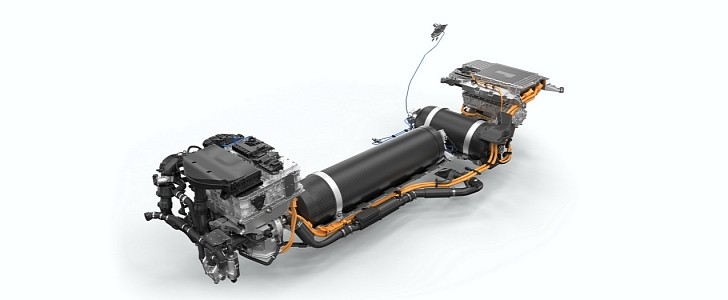BMW announced it started producing its own fuel cell system in Munich on August 31. The company still does not mention how many iX5 Hydrogen units these systems will help to power. However, it disclosed an interesting detail about its in-house production: the individual fuel cells actually come from Toyota.
The German and the Japanese automakers have been partners in fuel cell drive systems since 2013. The main difference between them is that Toyota has sold a hydrogen-powered vehicle since 2014: the Mirai. BMW is yet to take that step, which the iX5 Hydrogen could eventually bring to reality.
Although the individual fuel cells come from Toyota, BMW takes care of producing the fuel cell stack, which is an automated process. It involves putting an undisclosed number of fuel cells together. After that, the stacks are “compressed by machine with a force of five tonnes and placed in a housing.” BMW produces this aluminum housing at its foundry in Landshut, as well as the pressure plate. This component delivers hydrogen and oxygen to the fuel cell stacks and is made of plastic parts and light-alloy castings.
BMW seems to be really proud of the final result. According to the German automaker, its fuel cell has a high continuous output of 125 kW. However, the company states this is equivalent to 170 hp, which is not correct: 125 kW corresponds to 168 hp or 170 ps.
For the iX5 Hydrogen, BMW mates this fuel cell system with its fifth-generation BMW eDrive electric motors. The company also talks about a purpose-developed high-performance battery for this SUV, but it does not mention how big it is.
In the first technical images it released since it started talking about this car, BMW shows that its two hydrogen tanks present different sizes. The main one is a large cylinder placed longitudinally. The smaller one fits transversally right behind the main cylinder, a bit ahead of the rear motor. It seems that the battery pack is either too small to even appear in these technical drawings, or it was just omitted in them.
Although this car is good news for fuel cell advocates, BMW still owes them information on how many it intends to build and if it will be a plug-in vehicle – which would make a lot of sense. It should release these details by the end of 2022. That’s when these fuel cell electric vehicles (FCEVs) will start to operate around the world, probably only as experimental fleet vehicles.
Although the individual fuel cells come from Toyota, BMW takes care of producing the fuel cell stack, which is an automated process. It involves putting an undisclosed number of fuel cells together. After that, the stacks are “compressed by machine with a force of five tonnes and placed in a housing.” BMW produces this aluminum housing at its foundry in Landshut, as well as the pressure plate. This component delivers hydrogen and oxygen to the fuel cell stacks and is made of plastic parts and light-alloy castings.
BMW seems to be really proud of the final result. According to the German automaker, its fuel cell has a high continuous output of 125 kW. However, the company states this is equivalent to 170 hp, which is not correct: 125 kW corresponds to 168 hp or 170 ps.
For the iX5 Hydrogen, BMW mates this fuel cell system with its fifth-generation BMW eDrive electric motors. The company also talks about a purpose-developed high-performance battery for this SUV, but it does not mention how big it is.
In the first technical images it released since it started talking about this car, BMW shows that its two hydrogen tanks present different sizes. The main one is a large cylinder placed longitudinally. The smaller one fits transversally right behind the main cylinder, a bit ahead of the rear motor. It seems that the battery pack is either too small to even appear in these technical drawings, or it was just omitted in them.
Although this car is good news for fuel cell advocates, BMW still owes them information on how many it intends to build and if it will be a plug-in vehicle – which would make a lot of sense. It should release these details by the end of 2022. That’s when these fuel cell electric vehicles (FCEVs) will start to operate around the world, probably only as experimental fleet vehicles.



















